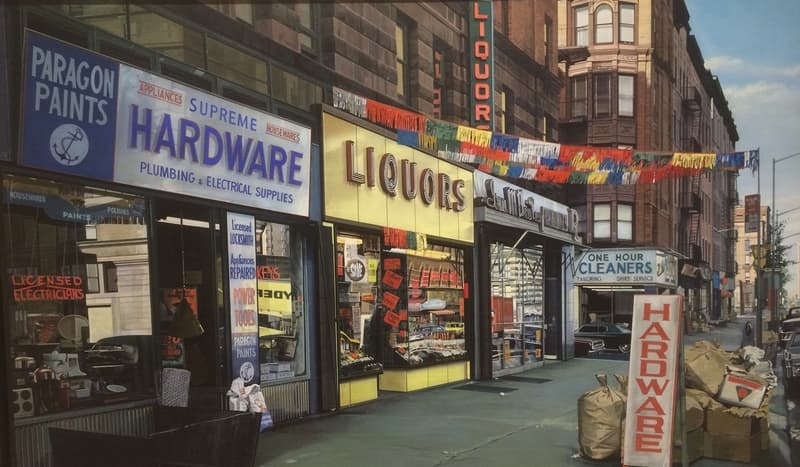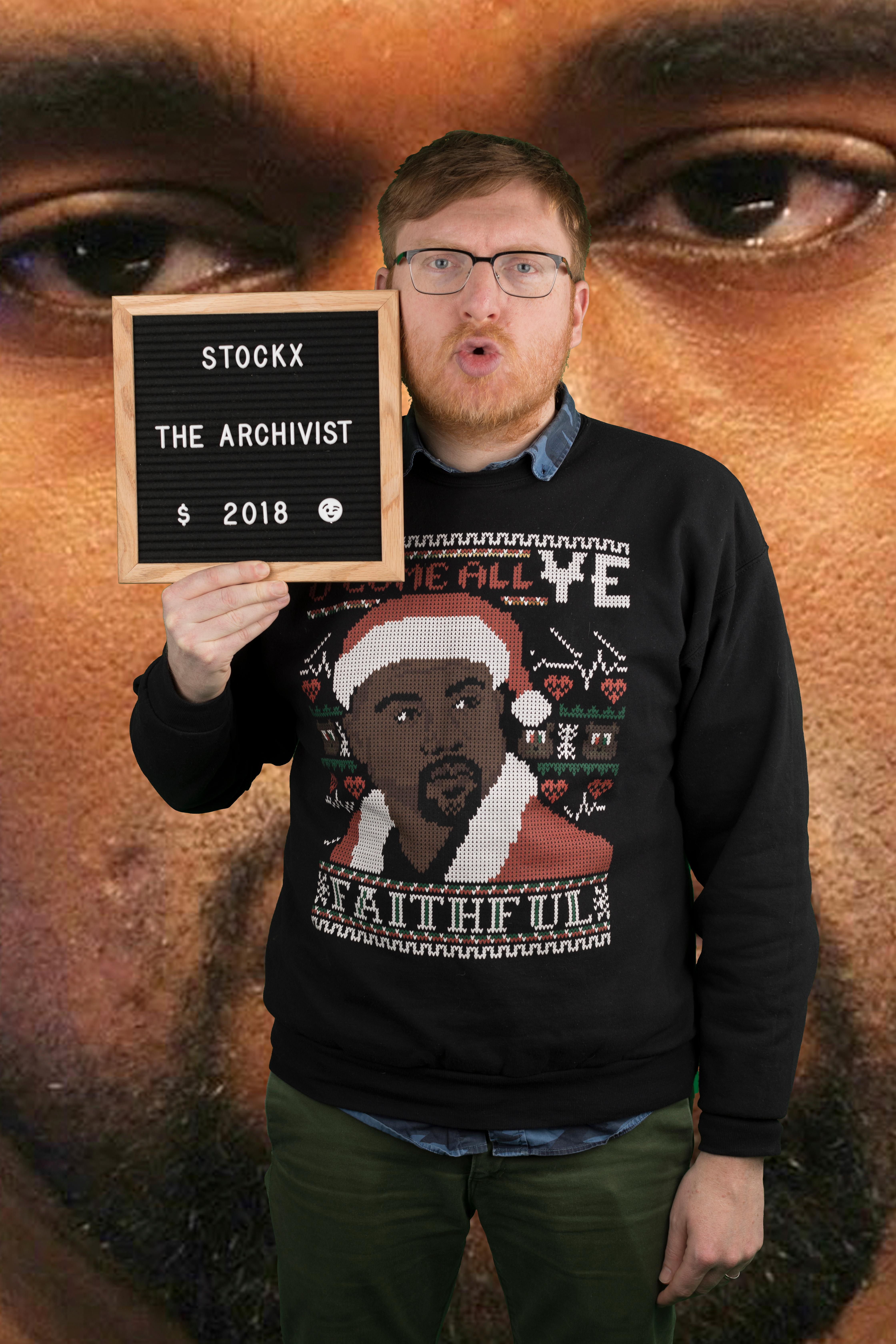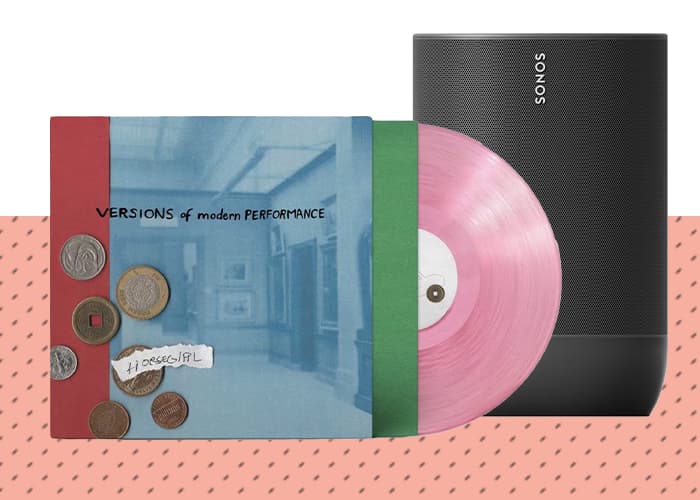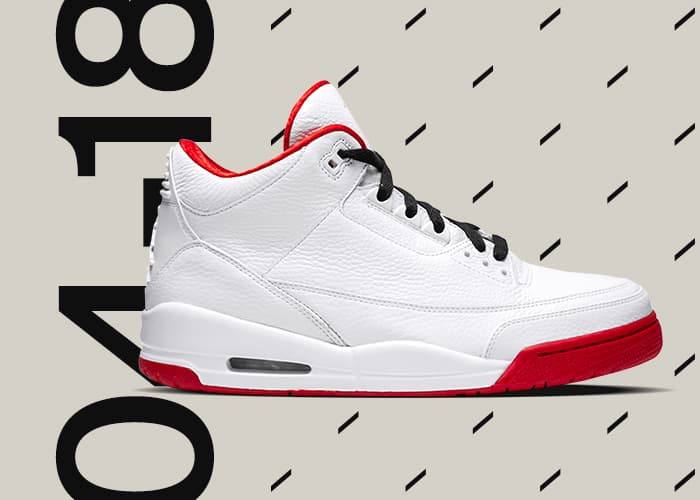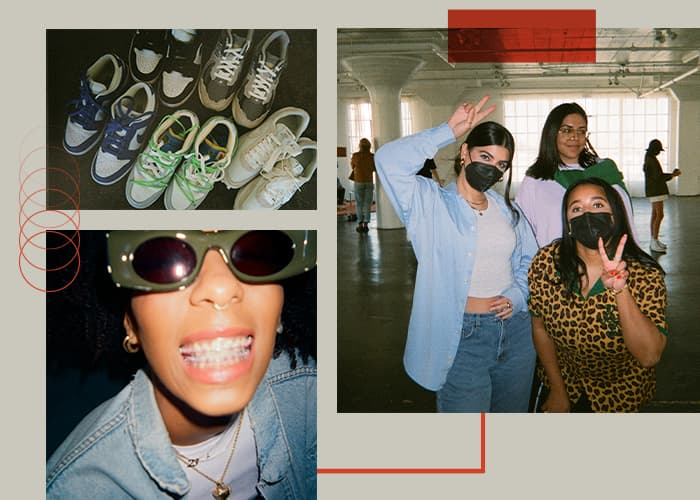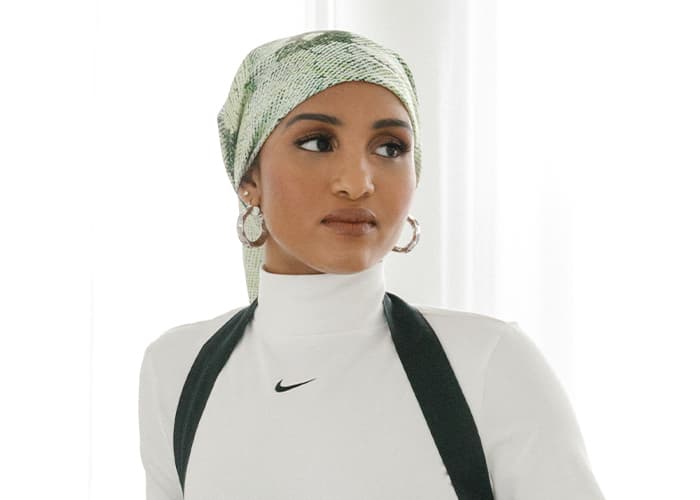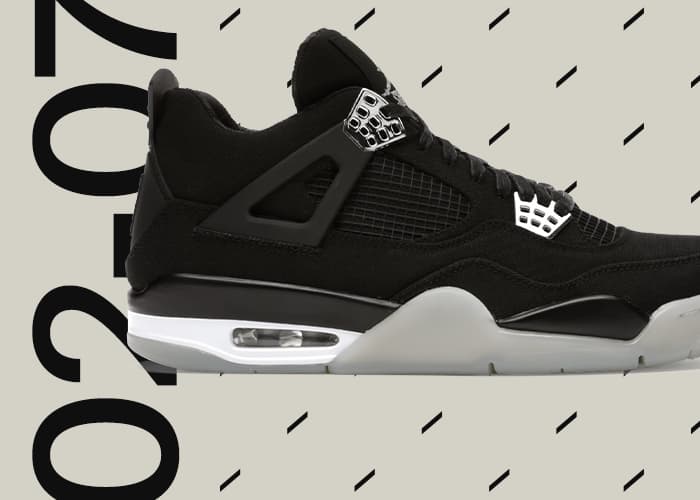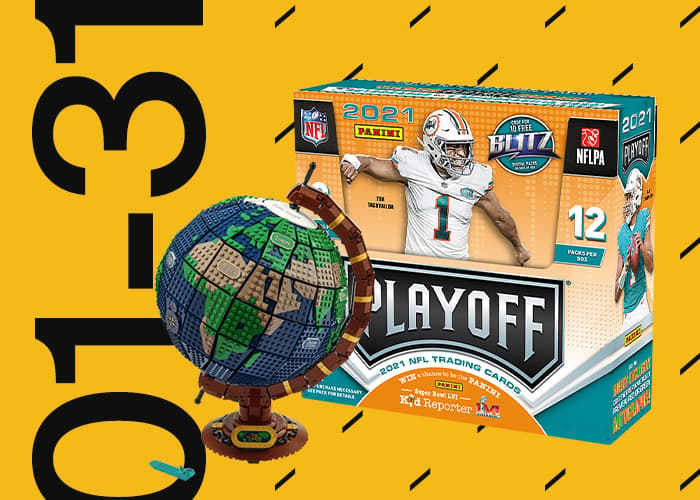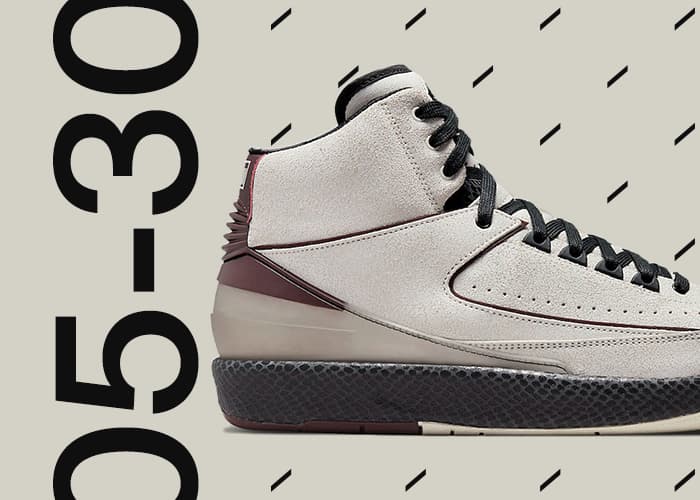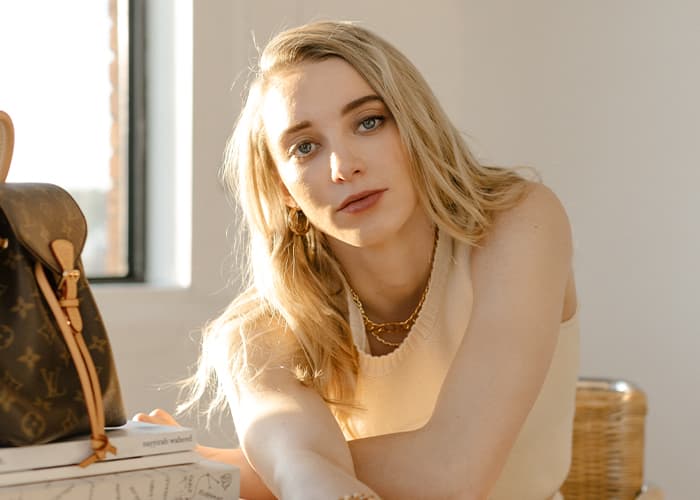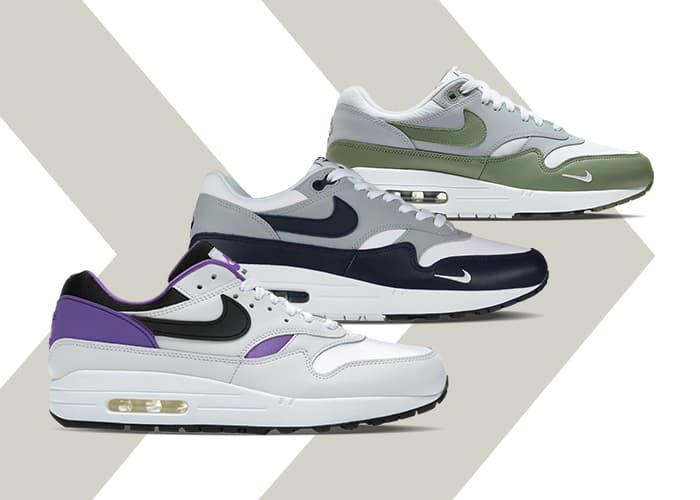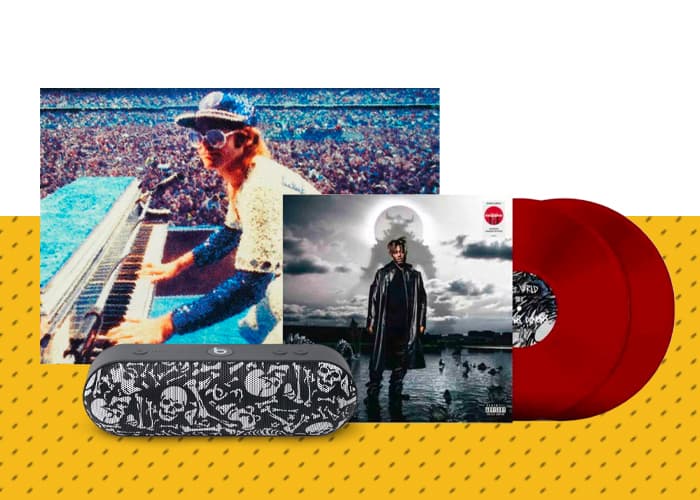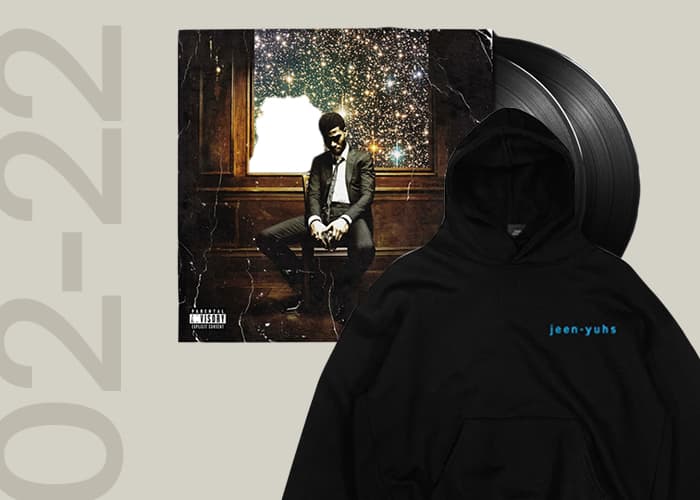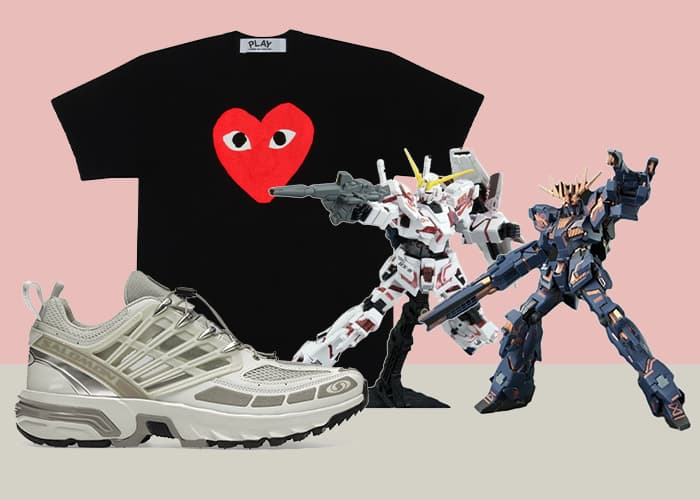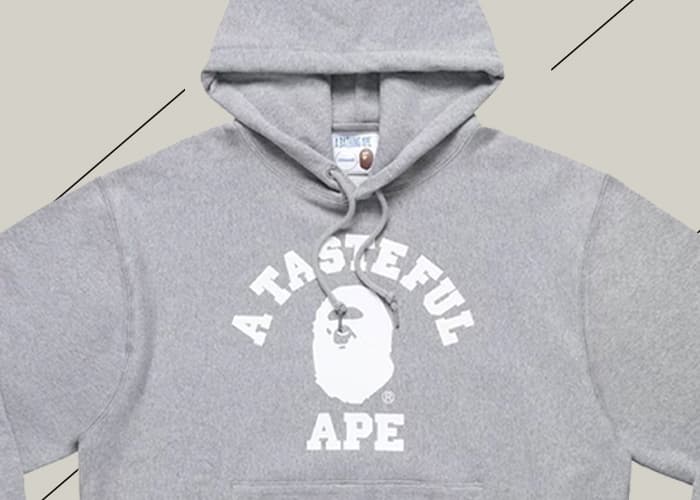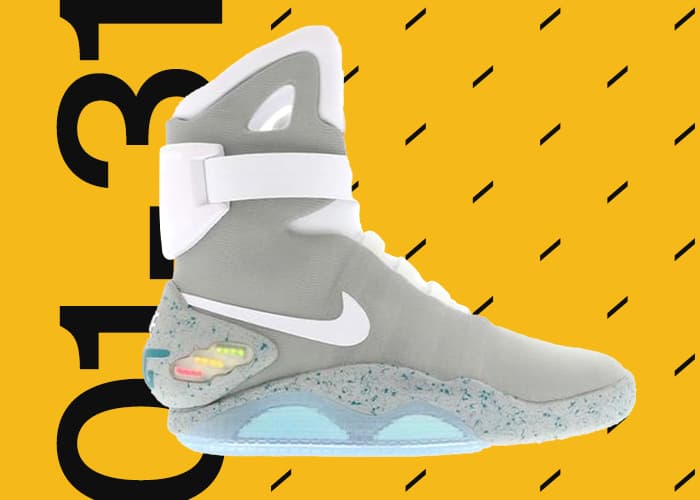
Richard Estes, “Supreme Hardware” (1974) // Artstack.com
Richard Estes is widely considered the leading Photorealist artist in the world and the premier painter of cityscapes during the last 50 years. From the late 1960s to the present, Estes has been photographing and painting street scenes from around the world. His most enduring paintings capture the hidden beauty of everyday life in New York.
During Supreme’s SS18 season, two of Estes’ early 1970s’ works, “Drugs” and “Supreme Hardware,” were transformed into clothing. Estes’ paintings were featured on the rayon “Drugs” shirt and “Supreme Hardware” top, which released in Week 16, along with a series of “Supreme Hardware” tees, which dropped in Week 19.
To kick off our SS18 review, we sat down with Mr. Estes at his home in Mount Desert, Maine earlier this month, and asked him about Supreme, streetwear, and his artistic process. Below is a transcript of our exclusive interview, which has been lightly edited for length and clarity.
***
StockX: Can you tell us how this collaboration with Supreme came about?
Richard Estes: They [Supreme] just approached the gallery [Marlborough Gallery]. They suggested the collaboration. I didn’t have anything to do with it.
Did Supreme talk about, or provide, product details?
I don’t remember. I think they showed me some sort of a sketch, but I didn’t take it very seriously.
Had you ever heard of the brand Supreme before?
No. Never heard of it. I still don’t know anything about them. Who are they? Supreme? I mean “Supreme Hardware” was one of the paintings they chose, so that makes sense for them.
“Are people speculating on these shirts?…I don’t know, it seems like a risk.”
Did you know what paintings Supreme wanted to use?
They showed me what they wanted to use. They’re some of the first paintings I ever made that actually sold. “Supreme Hardware” and “Drugs” around 1969 or 1970 [editor’s note: 1974 and 1970, respectively]….I don’t really remember, it was too long ago and the years have all merged.
Did you negotiate how you were compensated?
Supreme offered some money. I didn’t have anything to do with it. The gallery did everything and they said it might be a good thing to do, so I said ‘Ok.’
How did your paintings of the Supreme Hardware Store and the Drug Store come about?
It was my neighborhood. I was living on 75th street and Supreme Hardware was between 74 and 75 on Columbus. It was half a block away. The drug store was 72nd and Columbus. I’d go out on Sundays. I had no schedule. If I needed photos I went out and shot photos. I did it all myself.
What do you think about a fashion brand featuring your work?
I don’t know? Am I selling out? I don’t know… The gallery said it would reach a younger generation. That was their argument to me. The shirts aren’t cheap.
Yeah, at retail, the button-down and print shirts sold for over $100, and on StockX they’re reselling for even more.
Are people speculating on these shirts? They’re taking chance on reselling; maybe they won’t be popular or sell. I don’t know, it seems like a risk.
It can be a risk! What do you think about reselling and the secondary market- people buying and reselling shoes and clothes?
I think it’s bizarre. It is like art collectors, too. The whole art scene has become more like the stock market and speculating on value. People don’t even look at the painting anymore, they just buy it and put it in a closet and hope they can sell it for more money later.
What do you think about the state of the art world and the secondary art market?
It’s not very healthy, I don’t think. Eventually, this whole thing is going to collapse at some point. [For example] that drugstore painting that sold in 1970 went for about $20,000…I have no idea what it’s worth now. I’d rather not know…
I remember Andy Warhol, just before he died, they said: “Poor Andy, he can’t sell anything, so we commissioned him to do our portrait just so he could get some work.” Well of course he died and all his portraits are now reselling for lots of money.
“Advertising was the only thing I could figure out so that I could survive….I probably learned more from advertising than I ever did in art school.”
What was it about New York in the 1960s that made you want use photorealism to capture the urban landscape?
I don’t know. I just decided. Photorealism sort of came about from my work in advertising. I worked for almost 10 years doing ad illustrations. There you’d be working from photographs and a lot of times it would be of automobiles and modern things and I said, ‘why not just do this as a painting instead of an advertisement?’
How did you get your start in advertising?
I got out of art school in ‘55. And then I started working in different art studios, in Chicago. I moved to New York in ‘57 or ‘58 and then it was 10 years in New York in advertising. It was 10 years in New York before I had a show. [Indicating a figurative painting of his prior to the late 1960s] This is what I was doing for 10 years. This is what I was doing and no one wanted them. That’s why I still have all of these [his figurative paintings].
Advertising was the only thing I could figure out so that I could survive. Being a painter, drawing, designing, I couldn’t become any kind of executive, it’s not my personality. I probably learned more from advertising than I ever did in art school. I had absolutely no technique whatsoever when I started out, even though I had been to the art institute for 4 years. You don’t learn anything in art school, they just say ‘feel it, express yourself.’
I worked in the bullpen. I wasn’t the art director or anything. I was told, ‘give me a headline and picture of an exploding tire’ or something like that. You did it in ten versions to give the client a choice. I could knock out 4 ads in an hour. I was always on a freelance basis. I didn’t really work for any particular agency. I would get called in, basically. This was one reason I could do the painting. I would work 3 or 4 times a week and then I could paint.
“I have zero theory. I think Theory is sort of like monks arguing about how many angels are dancing on the head of a pin. It’s meaningless.”
Without your experience in advertising, would your work have turned to Photorealism?
I don’t know, maybe not. Through advertising, I started using photos. It was also viewed as dishonest to use photos for painting. But that’s how it was done for a lot of artists- Rockwell, Thomas Aikens, Degas. It was considered cheating, very bad and dishonest. In advertising it was ok. They were interested in advertising, not art. They wanted to sell stuff.
Why do reflections and reflective surfaces play such a big part in your work?
Mostly just to balance the composition. It was a question of design, to make the painting symmetrical. Also, I was just walking around the street and there it was in front of you. There’s a lot of glass in New York.
What’s the unifying theme in all the streetscapes you’ve painted?
I don’t know if they connect other than that’s what I would see when I go out every day. It’s the visual thing. It has no political meaning at all. I have zero theory. I think Theory is sort of like monks arguing about how many angels are dancing on the head of a pin. It’s meaningless.
I have this column of three statements, talking about art, and a bunch of phrases where you could mix-and-match ways to talk about art and theory [by arranging the phrases in the three columns]. Sometimes it makes sense, sometimes it doesn’t.
“Jeff Koons…I certainly wouldn’t want to have one of his things, his pornographic photos, hanging over my dining room table.”
What are your thoughts on Pop Art?
At the time, at least they were drawing images and not just doing squiggles or dropping paint on a canvas. It was sort of a relief! But it was sort of amateurishly done, too.
Any favorites in the Pop Art movement?
Well, I wouldn’t really want any of those paintings, frankly.
With your work being featured on Supreme T-Shirts, does that move you closer to Pop Art?
It has nothing to do with what I’m thinking or doing. All I do is make the pictures. In this case, it was very clear the gallery saw this as an advertisement in and of itself. But now my work has become an advertisement on the shirts of young people as an advertisement, which is great.
Why did your early paintings not have a lot of figures in them?
In the 1970s there wasn’t a lot of people in my paintings because there were no people in SoHo. It was a ghost town. I liked [taking photographs on] Sunday morning because it was deserted, you could focus on the buildings and architecture. I didn’t want to make it too sentimental. Sometimes if you put the people in and they start to ask, ‘what does this mean? It signifies loneliness and this and that, like Hopper.’
But I did cultivate ugliness, I didn’t want things to be too pretty. Look at “The Medusa” by Delacroix you wouldn’t want to be there and you wouldn’t want to hang it about your dinner table. It doesn’t have a lot of domestic qualities. A lot of paintings depict ugly scenes like executions and massacres and it’s still a beautiful painting.
Talk about your relationship to the New York art scene…
I think I’m much more accepted in places like Madrid than I am in New York. I had one show at the Met. I sort of lost interest in the New York art scene. I don’t think I went to more than three galleries all of last year. The Whitney once, and most of it was up for installations so there was nothing up to even see. I’ve never had a major show and at this point I don’t think I’d even want to. At this point, I’m sort of sick of having shows. I mean look at what they are showing- Jeff Koons. Things like that, it’s worse than Trump, actually. I certainly wouldn’t want to have one of his things, his pornographic photos, hanging over my dining room table.
The more obscure and unclear you are, you have more currency. Well, I don’t know. It’s always been like that. Most of the artists we appreciate today were never well regarded in their own time. At least it’s been that when since the beginning of the 19th century until now.
Now you go to the Met and there’s a picture of something with a huge block of interpretation. No one looks at the painting they only read the interpretation. Tom Wolfe wrote about how the art scene had just become more about the word than the actual painting, in “The Painted Word.”
“If it’s really ugly, paint it….Supreme Hardware is not the Sistine Chapel.”
Would you work with Supreme again?
I didn’t really work with them, I just let them use the image. Well if they gave me enough money, I guess…
What would be your best painting to have on an article of clothing?
It doesn’t make a difference. Maybe one of my landscapes. I did prefer the corner drug store [the Supreme Drugs Button Down Shirt] to the Supreme Hardware because it worked from a design perspective.
Have you ever been into fashion?
No, I never have. Except for some of the ads I did. How could Supreme be around for 25 years and I’ve never even heard of them? I couldn’t even name any fashion designers, let alone say that I admired any.
I don’t own an Armani suit. I wouldn’t spend that kind of money on a suit. I used to pick out my clothes very carefully, but I didn’t have the kind of money to be into it.
Do you have an artist’s statement?
If it’s really ugly, paint it. Yeah, I painted ugly scenes. I mean, I didn’t paint architectural masterpieces. Supreme Hardware is not the Sistine Chapel.
Like I say, I don’t make those judgments. If something strikes me, if one of my photos strikes me, I’ll paint it.
Do you want to take a picture holding up the shirt?
No. Why would I want to advertise it?


